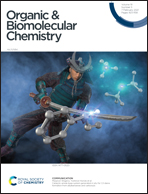Catalytic amide base system generated in situ for 1,3-diene formation from allylbenzenes and carbonyls†
Abstract
The amide base generated in situ from tetramethylammonium fluoride and N(TMS)3 catalyzes the synthesis of 1,3-diene from an allylbenzene and carbonyl compound. The system is applicable to the transformations of a variety of allylbenzenes with functional groups (halogen, methyl, phenyl, methoxy, dimethylamino, ester, and amide moieties). Acyclic and cyclic diaryl ketones, pivalophenone, pivalaldehyde, and isobutyrophenone are used as coupling partners. The role of trans β-methyl stilbenes in product formation is also elucidated.

- This article is part of the themed collection: Synthetic methodology in OBC


 Please wait while we load your content...
Please wait while we load your content...